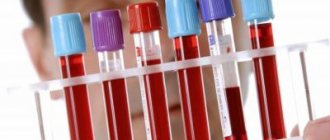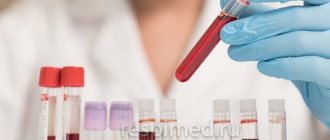During pregnancy, a woman has to undergo a large number of different tests. And how to figure out what is really needed and why.
In the last few years, a glucose tolerance test has been included in a number of mandatory examinations of pregnant women. What it is?
Oral glucose tolerance test (OGTT) is a test for glucose tolerance. It helps to identify carbohydrate metabolism disorders during pregnancy. This test can detect gestational diabetes mellitus (GDM), an increase in blood sugar levels associated with pregnancy.
This information is of particular value due to the fact that all pregnant women are at risk for developing diabetes mellitus due to changes in metabolic reactions during this period. As a rule, gestational diabetes is not dangerous and disappears after childbirth, but in the absence of supportive therapy it poses a risk to pregnancy and the fetus and, in some cases, can develop into manifest type 2 diabetes in the future.
In addition, gestational diabetes is rarely accompanied by clear specific signs, and therefore it is very difficult to detect it in a timely manner without a test. In fact, GTT makes it possible to detect diabetes that occurs in a latent form.
At what stage is a glucose tolerance test done during pregnancy?
The most optimal period for carrying out GTT is considered to be 24-26 weeks. In general, the test is done between 24 and 28 weeks for all pregnant women.
According to indications, this examination is carried out earlier if the expectant mother is at risk.
Risk groups include:
- A pregnant woman who is overweight (body mass index exceeds 30);
- sugar in the urine of a pregnant woman;
- the woman was diagnosed with gestational diabetes during previous pregnancies;
- relatives with diabetes
- bearing a large fetus;
- previous birth of a large child;
- analysis upon registration revealed a blood plasma glucose level above 5.1 mmol/l.
In any of the above cases, a glucose tolerance test is carried out at 16-18 weeks. Then at 24-28 weeks it is repeated. If necessary, GTT can also be performed in the third trimester, but no later than 32 weeks, since the glucose load poses a danger to the fetus at this period.
How is a glucose tolerance test performed during pregnancy: preparation
GTT is carried out by collecting venous blood on an empty stomach. If the result is elevated, the test is stopped and the pregnant woman is diagnosed with gestational diabetes. If the glucose value is below the upper limit of normal, an oral glucose tolerance test is performed.
The woman drinks a glucose solution (for this, 75 g of dry glucose is diluted in 250-300 ml of warm water) - and an hour after taking it, the blood test is repeated. If normal results are obtained, the analysis can also be carried out a third and fourth time - 2 hours or more after taking the glucose solution. Thus, there is a one-, two- and three-hour test.
Before taking a glucose tolerance test during pregnancy, you should not eat anything other than plain water 10-14 hours before donating blood. It should be noted that any drug therapy (including vitamin therapy) can distort the test results, and therefore you should also refrain from taking medications at this time. It is prohibited to drink alcohol or smoke the day before the test.
Diet can also affect the test results: for at least three days before the examination, a woman should eat as usual, consuming at least 150 g of carbohydrates per day.
A lack of potassium or magnesium in the body, some endocrine disorders and other diseases, physical and emotional stress can cause false GTT results.
Laboratory workers should warn the pregnant woman that she must remain physically calm until testing is completed. It is also important that the woman drinks the entire glucose solution no longer than within 5 minutes.
It should be noted that this is a very sweet, cloying drink, and it can make a woman sick. For this reason, a glucose tolerance test during pregnancy is not performed in cases of severe early toxicosis.
What is GTT
The glucose tolerance test (GTT) is a laboratory research method for identifying a huge number of diseases, both initial and latent.
WARNING! The information on the site is provided for informational purposes and cannot be used to make a diagnosis or make treatment decisions. GTT is also often called a “sugar load”; it helps to detect disorders of carbohydrate metabolism and identify blood glucose levels.
Pregnant women are primarily at risk. Often their disease is temporary and disappears after childbirth. This condition is called gestational diabetes.
According to statistics, 14% of expectant mothers suffer from this disease. Without support from the body and appropriate treatment, it can pose a threat to both the mother and the fetus.
The basic rule of the study is to repeatedly measure glucose levels. Initially, blood is drawn on an empty stomach. Then comes the “sugar load” and, after glucose has entered the blood, a repeat analysis is performed.
Thanks to this system, it is possible to determine how cells perceive glucose and how much time it takes.
General information
Diabetes mellitus in pregnant women (gestational) has differences in comparison with the classic course of the disease. First of all, this concerns the quantitative indicators of the test - what for non-pregnant patients predetermines a violation of carbohydrate metabolism, for expectant mothers can be considered the norm. That is why, to study pregnant women, a special glucose tolerance test is performed using the O'Sullivan method. The analysis involves the use of a so-called “sugar load”, which makes it possible to identify the pathology of glucose absorption in the body.
Note: expectant mothers are at risk for developing diabetes. This is due to the restructuring of metabolic processes in the body, as a result of which disturbances in the absorption of one or another component are possible. In addition, gestational diabetes can be asymptomatic for a long time, so it is difficult to diagnose it without GTT.
Gestational diabetes itself is not dangerous and goes away on its own after the baby is born. However, if you do not provide supportive therapy that is safe for mother and baby, the risk of complications increases. Also among the dangerous consequences for women is the development of type II diabetes mellitus.
Gestational diabetes is associated with an increased risk of obesity, glucose intolerance, and type 2 diabetes in the offspring.
In what cases is it prescribed
In expectant mothers, insulin resistance increases after the second trimester, for this reason, it is recommended to undergo testing at 16-18 weeks. Then repeat at 24-28 weeks.
If necessary, they offer to undergo the study again, but no later than 32 weeks.
The main destination factors are:
- heredity - close relatives suffer from diabetes;
- the age of the expectant mother exceeds 35 years;
- during a previous pregnancy, the birth of a large child from 4.5 kg;
- treatment for infertility using hormonal drugs;
- in the past, fetal fading;
- polyhydramnios;
- overweight.
GTT is prescribed earlier if the pregnant woman:
- sugar found in urine;
- obesity;
- gestational diabetes was previously diagnosed;
- there is a hereditary predisposition;
- large fruit.
Indications
GTT is prescribed to all pregnant women to screen for gestational diabetes between 24 and 28 weeks of pregnancy.
A glucose tolerance test is prescribed for pregnant women up to 24 weeks who are at risk for:
- presence of diabetes in a family history;
- development of gestational diabetes in previous pregnancies;
- body mass index exceeds a factor of 30 (obesity);
- mother's age 40 years and older
- history of polycystic ovaries
- carrying a large child (from 4-4.5 kg) or a history of births of large children;
- a preliminary biochemical analysis of the pregnant woman’s urine showed an increased concentration of glucose;
- a blood test showed a plasma sugar level of more than 5.1 mmol/l, but below 7.0 mmol/l (since fasting glucose above 7 mmol/l and above 11.1 mmol/l in a random sample allows you to immediately establish sugar diabetes.)
The test is not advisable in the following cases:
- early toxicosis with pronounced symptoms;
- liver diseases;
- pancreatitis (inflammation of the pancreas) in acute form;
- peptic ulcers (damage to the inner lining of the digestive tract);
- stomach ulcer, gastritis;
- Crohn's disease (granulomatous lesions of the digestive tract);
- dumping syndrome (acceleration of the movement of stomach contents into the intestines);
- the presence of inflammatory, viral, infectious or bacterial diseases;
- late pregnancy;
- if necessary, strict bed rest;
- with a fasting glucose level of 7 mmol/l and above;
- while taking medications that increase glycemic levels (glucocorticoids, thyroid hormones, thiazides, beta blockers).
How to prepare for analysis
You should not eat or drink anything for about 8-10 hours before the test. Have a good night's sleep and be completely healthy.
Before taking the glocotolerance test, the following rules should be observed:
- avoid stressful situations, they can affect the results - increase or decrease glucose levels;
- give up physical activity for a couple of days;
- testing during a cold is not recommended;
- exclude receiving medications. If it is not possible to do without them, take them after passing the test;
- In the morning you should not brush your teeth or chew gum;
- A few days before the test, it is advisable to change your diet. You can eat: a variety of cereals; lean boiled meat or fish; low fat dairy products; fruits and vegetables; weak herbal tea;
- should not be consumed: smoked; fat; roast; with a high content of seasonings and salt; confectionery treats; sweet drinks; tea and coffee; drinking alcohol and cigarettes.
With severe toxicosis, it may be difficult for you to drink a sugary solution. It is worth warning the laboratory assistant about this. In this situation, you will not have to drink liquids, but the drug will be given to you intravenously.
Preparation for GTT
To conduct a glucose tolerance test, venous blood is required, so the preparation rules for venipuncture are standard:
- blood is donated strictly on an empty stomach (break between meals is at least 10 hours);
- on the day of the test you can drink only plain water without carbonation, other drinks are prohibited;
- It is advisable to perform venipuncture in the morning (from 8.00 to 11.00);
- on the eve of the analysis, it is necessary to abandon drug and vitamin therapy, since certain drugs can distort the test result;
- the day before the procedure, it is advisable not to overwork yourself either physically or emotionally;
- It is prohibited to drink alcohol and smoke before the test.
Additional dietary requirements:
- 3 days before venipuncture, it is forbidden to follow diets, fasting days, water fasting or fasting, or change your diet;
- Also, 3 days before the test you must consume at least 150 grams. carbohydrates per day, while the last meal on the eve of venipuncture should contain at least 40-50 grams. carbohydrates.
How is it carried out?
The test is carried out in the morning on an empty stomach by drawing blood from a vein. Then the laboratory assistant invites the patient to drink the syrup. It is prepared from 200-300 milliliters of water with the addition of 75-100 grams of glucose. You can add a couple of drops of lemon juice.
After a certain period of time - an hour, testing is repeated. And an hour later they repeat it. Thus, you will have to spend at least three hours in the clinic.
Thanks to this method, a specialist can determine how cells perceive glucose, how the blood glucose level changes and how much time is needed.
The first blood indicator indicates what the coefficient is at the initial level. After a “sugar load,” the indicator rises sharply, and after some time, it should drop again.
It is necessary to ensure that during the period of time between blood draws, the patient does not eat anything, moves little, does not worry and behaves calmly.
In many laboratories, special rooms and conditions have been created for expectant mothers to take the tolerance test.
Norms and deviations of the glucose tolerance test in pregnant women
Norm indicators for pregnant women:
- the initial blood count taken on an empty stomach is no more than 5.8 mmol/l;
- after 60 minutes after taking syrup – 10 mmol/l;
- after 120 min. – 8.6 mmol/l;
- after 180 min. – 7.8 mmol/l.
When GTT levels are higher than standard values or are close to the upper limit of 7.8 mmol/l, this may indicate poor glucose tolerance and suggest the existence of gestational diabetes.
If the result is more than 11.1 mmol/l, there is reason to suspect possible diabetes mellitus.
The final diagnosis can be established by a doctor only after passing two or three studies.
To avoid obtaining incorrect or distorted results, testing is repeated after two weeks.
Reasons for incorrect results
During pregnancy, hormonal levels change and metabolism proceeds differently. Therefore, the coefficients may change and differ from the norm.
Many factors can influence performance. Among them, experts note:
- poor nutrition;
- stressful state;
- poor sleep;
- physical exercise, long walks;
- fatigue;
- drug use;
- infectious diseases.
Also, the patient should take all the syrup within a maximum of 5 minutes.
High levels of GTT can be influenced by endocrine pathologies, or low levels of potassium or magnesium in the body.
For this reason, the study must be repeated after a couple of weeks.
Decoding
| Test stage | Norm | Gestational diabetes | Manifest SD |
| 1st (on an empty stomach) | up to 5.1 mmol/l | 5.1 – 6.9 mmol/l | Over 7.0 mmol/l |
| 2nd (1 hour after exercise) | up to 10.0 mmol/l | more than 10.0 mmol/l | — |
| 3rd (2 hours after exercise) | up to 8.5 mmol/l | 8.5 – 11.0 mmol/l | over 11.1 mmol/l |
Note: if at the first stage of the test the fasting blood glucose level exceeds 7 mmol/l, then additional diagnostics are performed (determination of glycosylated hemoglobin, C-peptide) and a diagnosis of “diabetes mellitus of a certain type” (gestational, type 1, 2) is made. After this, an oral exercise test is prohibited.
There are a number of nuances to deciphering the test:
- only venous blood is indicative (it is not recommended to use arterial or capillary blood);
- established reference values do not change with the duration of pregnancy;
- after exercise, one value is sufficient to diagnose gestational diabetes;
- if ambiguous results are obtained, the test is repeated after 2 weeks to exclude a false result;
- the analysis is repeated after childbirth to confirm or refute gestational diabetes.
Factors that may affect the result:
- deficiency of microelements (magnesium, potassium) in the body;
- disturbances in the functioning of the endocrine system;
- systemic diseases;
- stress and anxiety;
- simple physical activity (moving around the ward during the test);
- taking sugar-containing medications: cough medicines, vitamins, beta blockers, glucocorticosteroids, iron supplements, etc.
The appointment and interpretation of the analysis is carried out by a gynecologist, endocrinologist.
How to behave after the analysis
Women in this position often have an increased appetite, and a constant feeling of hunger haunts them. Many expectant mothers complain that they have to go to the clinic on an empty stomach.
In addition, you need to spend at least three hours in the hospital, and on the way home, you may experience dizziness and pain in the epigastric area.
This can easily be avoided if you take a bottle of juice and a sandwich with you.
After the third blood draw, you need to rest, take your time, eat and boldly hit the road.
Contraindications
You cannot test if blood sugar coefficients at the initial stage exceed 6.7 mmol/l. Additional glucose intake can cause hyperglycemia.
Contraindications for testing:
- pancreatitis - a disorder of the liver;
- chronic diseases of the gastrointestinal tract;
- "acute abdomen" syndrome;
- Crohn's disease;
- peptic ulcers;
- observance by the expectant mother of bed rest;
- infectious diseases;
- 3rd trimester.
It should be said that the “sugar load” tastes like a sweet, cloying syrup, and it is often very difficult for a pregnant woman to drink it - she may vomit. Especially if the patient has toxicosis.
Laboratory assistants allow you to add a couple of drops of lemon to the liquid; if this does not help, then the test will need to be repeated. But at the same time, glucose will be administered intravenously.





